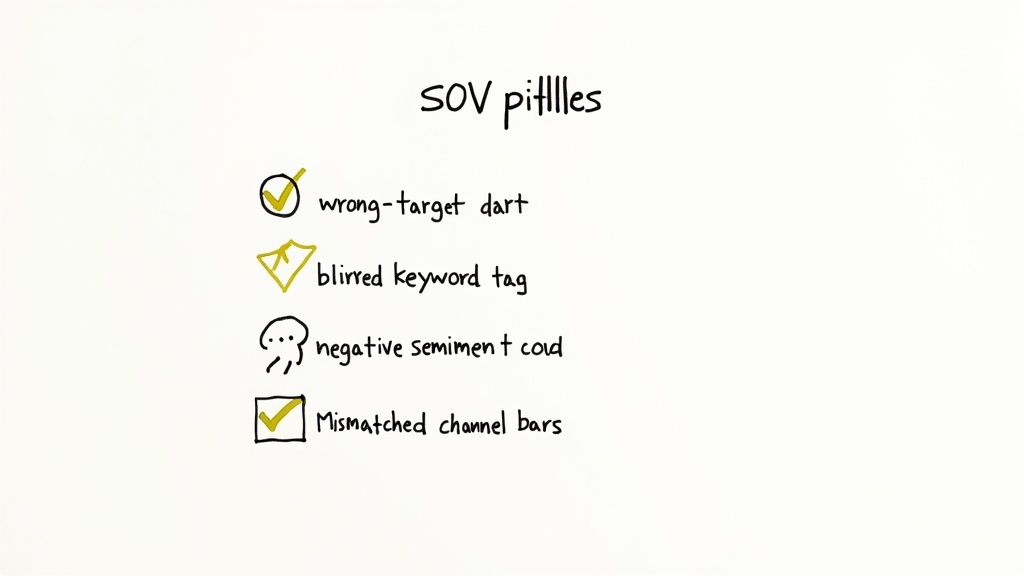Calculating share of voice is often boiled down to a simple formula: your brand mentions divided by total market mentions. But this common method is deeply flawed. It treats all visibility as equal, and that’s a dangerous assumption in today’s market.
Real share of voice (SOV) isn't about counting how many times your name comes up.
It's about understanding the quality and impact of your visibility.
Why Your Current Share of Voice Formula Is Broken
Most guides offer the same tired advice: track every mention, add them up, and see how you stack up. The problem is, this approach spits out data that is often meaningless—and sometimes, dangerously misleading.
It fails to distinguish between valuable visibility and a full-blown reputation crisis.
Imagine your brand's SOV skyrockets to 30% overnight. Looks like a massive win, right? But what if that spike is driven by a wave of negative reviews or a viral customer complaint? The classic formula counts this as a victory, even while your brand equity is tanking. Visibility is not the same as influence.
All Mentions Are Not Created Equal
The core issue is that the simplistic formula ignores context. It doesn't account for the critical factors that determine a mention's real value. This is a common blind spot that leads to poor strategic decisions.
Here's what that basic formula misses:
- Sentiment: It can't tell the difference between a glowing customer testimonial and a scathing product critique. It's all just a "mention."
- Relevance: It doesn’t weigh a feature in a major industry publication more heavily than a random social media post with zero engagement.
- Authority: An endorsement from a trusted expert is far more impactful than a mention from a bot account, but the old formula treats them the same.
A high share of voice from negative press is a liability, not an asset. When your brand dominates the conversation for all the wrong reasons, you aren't winning; you're just loud while you're losing.
Mini Case Study: The Danger of Ignoring Quality
Remember when United Airlines had its major PR crisis in 2017? Its share of voice in the airline industry spiked, but this was entirely negative press. Tracking that metric without sentiment would have painted a wildly inaccurate picture of brand health.
Brands that combine SOV with sentiment analysis see a 30% improvement in campaign ROI compared to those just tracking mentions alone, according to multiple industry analyses. You can explore more on this in our detailed guide to share of voice measurement.
This is why we need to reframe how we calculate share of voice—moving from raw numbers to strategic context. Before you calculate anything, distinguish between simple visibility and genuine market influence. This is the first step toward accurate, useful brand measurement. For more on how modern analytics improve ROI, the team at NewzGroup's blog has some great insights.
Define Your Battlefield: Where to Calculate SOV
Before you calculate anything, you must decide where you're competing. A single, universal SOV number is a myth. An accurate calculation requires measuring your presence in specific arenas where your customers actually pay attention.
Trying to blend social media mentions with SEO impressions is like comparing apples and oranges—it just gives you a meaningless number. Focus your efforts on the channels that genuinely matter to your brand.
This illustration nails the shift from that flawed, all-in-one approach to a much sharper, channel-specific method.

Ditching the old way gives you reliable data—the kind you can use to make real strategic decisions, not just fill a box on a spreadsheet.
The Three Core Battlefields
For most brands, the fight for attention happens across three main channels. Each has its own formula and tools for getting the measurement right.
- Social Conversation (Social SOV): This is your brand’s slice of the conversation on social media. It includes not just your posts, but who is talking about you, your competitors, and your industry. The core metric is brand mentions.
- Organic Search (SEO SOV): This reflects your visibility on search engine results pages (SERPs). It's a direct indicator of how well your content competes for your audience's organic attention against rivals for the keywords that matter. The metric to track is keyword impressions or visibility score.
- Paid Media (PPC SOV): This is the most traditional form of SOV, measuring your ad presence. It shows how often your paid ads are seen compared to the total number of times they could have been seen. You'll be tracking impression share.
Formulas and Tools by Channel
Applying the right formula to each channel is non-negotiable. At its heart, share of voice is about comparing your brand’s visibility to the total activity in your market. For example, if your brand got 200 social media mentions this week, and the total for all brands in your category was 2,000, your SOV is 10%. Smart teams use platforms like Sprout Social to track these mentions and turn raw data into an actionable SOV percentage. For a deeper dive, check out insights from the experts at Promodo.
The table below breaks down how to approach each channel.
Share of Voice Calculation by Channel
| Channel | Metric to Track | Formula | Example Tools |
|---|---|---|---|
| Social SOV | Brand Mentions | (Your Brand Mentions / Total Market Mentions) x 100 | Brandwatch, Talkwalker, Google Alerts |
| SEO SOV | Keyword Impressions | (Your Keyword Impressions / Total Market Keyword Impressions) x 100 | Semrush, Ahrefs, AI SEO Tracker |
| PPC SOV | Impression Share | Your Impression Share (provided by the ad platform) | Google Ads, Microsoft Advertising |
By breaking down SOV by channel, you transform it from a vague concept into precise, actionable KPIs. This targeted approach is the only way to get a true picture of your market position and spot real growth opportunities.
Walkthrough: Calculating SEO Share of Voice
Theory is great, but let's get practical. The best way to understand how you calculate share of voice for SEO is to walk through a realistic scenario. We'll use a fictional B2B SaaS company, "SyncUp," to give you a reusable framework.
SyncUp is fighting for ground in the crowded project management software space against heavyweights like Asana and Trello. They need to calculate their organic search SOV to understand their true visibility.
Step 1: Define the Keyword Set
First, the SyncUp team defines their battlefield. They aren’t trying to rank for every keyword. Instead, they want to own the conversation around high-intent, bottom-of-funnel keywords—the terms people search when they're ready to buy.
They identify a tight list of 20 keywords their ideal customers use.
This list includes terms like:
- "best project management software for small teams"
- "asana vs trello alternatives"
- "kanban board software for developers"
Getting this keyword list right is the foundation of an accurate SOV calculation. It's all about finding the best keywords for SEO that define your competitive landscape.
Step 2: Gather Ranking and Volume Data
The SyncUp team uses Semrush to pull two critical data points for their 20 keywords: the monthly search volume for each term, and where they, Asana, and Trello currently rank. This gives them a snapshot of the total market opportunity.
But rankings alone don't tell the whole story. Ranking #1 doesn't guarantee you get 100% of the clicks. They need to translate rankings into estimated traffic. For this, they use a standard click-through rate (CTR) model based on organic position:
- Position 1: 28% CTR
- Position 2: 15% CTR
- Position 3: 11% CTR
- And so on.
Here’s the kind of data they'd see in Semrush's Keyword Overview tool for just one of their target keywords.

This view provides the monthly search volume and keyword difficulty, the raw ingredients for calculating total potential impressions.
Step 3: Apply the SOV Formula
With the data collected, SyncUp can calculate the estimated monthly impressions for each company. The formula is refreshingly simple:
Monthly Search Volume x CTR % for Ranking Position = Estimated Monthly Impressions
They run these numbers for all 20 keywords for each of the three companies, then add up the totals.
Here’s the final tally:
- Total Market Impressions (SyncUp + Asana + Trello): 120,000
- SyncUp’s Total Impressions: 9,600
- Asana’s Total Impressions: 54,000
- Trello’s Total Impressions: 56,400
Finally, they plug these numbers into the SEO SOV formula:
(Your Brand's Impressions / Total Market Impressions) x 100 = SEO Share of Voice
For SyncUp, the math is: (9,600 / 120,000) x 100 = 8% SEO Share of Voice.
This isn't just a vanity metric. This number gives SyncUp a clear, data-backed benchmark. They now know they command 8% of the organic visibility for their most valuable keywords. You can explore other ways to calculate share of voice to adapt this method, but for SEO, this gives them a baseline to measure the impact of their content efforts against their top competitors.
Where Share of Voice Came From (and Why It Matters)
To get a handle on calculating share of voice today, it helps to know where the concept came from. It's not a new idea; it's a classic measure of market presence that has evolved with technology. Its history is proof that SOV is more than a vanity metric—it’s a foundational piece of understanding market penetration.
Originally, SOV was dead simple. In the world of traditional advertising, brands like Coca-Cola and Pepsi measured dominance by one thing: ad spend. They tracked their share of television commercials, radio spots, and print ads against their rivals.
That was the classic definition—your piece of the total advertising pie.
From Broadcast to Clicks
In the early 2000s, it was normal to calculate SOV based on TV ad spend. During peak seasons, Nielsen might report that Coca-Cola held a 12% SOV in the U.S. soft drink category. That number gave them a clear benchmark of their advertising power.
Today, the same principle applies, but the battlefield is completely different. A modern SaaS company might be tracking impressions for 50 high-value keywords, discovering their site gets 15,000 impressions monthly out of a total 100,000 for all competitors in that space.
That gives them an SEO SOV of 15%. The core idea—measuring your presence against the total market—is the same. The channels have just changed.
The Modern Battlefield: Digital Conversations
The biggest shift has been from a one-way broadcast model to a massive, two-way digital conversation. SOV is no longer just about what you pay to say about yourself. It's about what everyone else is saying about you online.
This now includes:
- Organic Search Visibility: How often do you show up when customers are looking for answers?
- Social Media Mentions: Who’s talking about your brand, and is it good or bad?
- PR Coverage: What’s your footprint in online publications and news sites?
The definition of "voice" has exploded to cover every digital touchpoint where your brand can be seen, heard, or discussed.
The fundamental principle of Share of Voice hasn't changed. We're still measuring our presence in a competitive arena. The arena just expanded from three TV networks to millions of digital conversations happening every second.
And this evolution isn't stopping. With AI search becoming more common, the game is changing again. Understanding how to get platforms like ChatGPT and Perplexity to recommend your brand is the new frontier. This requires fresh AI SEO strategies to get recommended by LLMs.
Knowing this history helps you make the case for SOV's strategic importance. It’s not a fleeting trend but a core business metric that has adapted for decades. Your brand needs to adapt with it.
3 Mistakes That Will Invalidate Your SOV Data

Knowing how you calculate share of voice is only half the battle. A poorly calculated SOV is worse than no data at all—it sends you chasing the wrong goals and making flawed strategic bets.
Accuracy comes from avoiding common pitfalls. Remember, your data is only as good as your inputs.
Mistake #1: Picking the Wrong Competitors
This is the most frequent and damaging mistake. Measuring your local coffee shop’s social media mentions against Starbucks is a waste of time. Their market, budget, and audience are on a different planet. Your SOV will be a rounding error, telling you nothing useful.
Your competitor set must be surgically precise.
- Direct Competitors: Brands offering a similar product to the same audience.
- Indirect Competitors: Brands solving the same customer problem with a different solution.
- Aspirational Competitors: Market leaders you aim to challenge within a specific niche.
A small B2B SaaS company should track its SOV against 2-3 similarly sized rivals, not an enterprise giant like Salesforce. Focus on rivals you can realistically take market share from.
Mistake #2: Ignoring Sentiment
Raw mention counts are a classic vanity metric. A spike in mentions could mean your new feature is a hit, or it could mean your server just crashed for five hours. Without sentiment analysis, you have no idea which it is.
A 15% SOV composed of angry customers is a liability, not an asset.
A high volume of negative mentions isn't "brand awareness"—it's a fire alarm. Ignoring sentiment is like measuring the noise in a building without checking if it's applause or a smoke detector.
Mistake #3: Blending Unrelated Channel Data
It’s tempting to mix your SEO, social, and PPC SOV into one master metric. Don’t do it. A keyword impression is not the same as a TikTok mention, and averaging them creates a meaningless, Frankenstein number.
Each channel tells a different story about your brand’s visibility.
- SEO SOV reflects your authority and content relevance in search.
- Social SOV measures your cultural relevance and the conversation around your brand.
- PPC SOV shows your dominance in paid advertising.
Keep them separate. This allows you to see that your content strategy is crushing it in search, but your social media presence is lagging. These distinct insights are critical for allocating resources and are a core part of a useful share of voice report. Blending data hides your true weaknesses and strengths.
Your Top Share of Voice Questions, Answered
Here are direct answers to the most common questions marketers ask when they start calculating share of voice.
How often should I calculate share of voice?
It depends on how fast your market moves.
For a fast-paced industry like consumer tech, a weekly or bi-weekly check on social SOV is smart to catch trends.
For organic SEO, a quarterly calculation is usually enough. This is sufficient to see the impact of your content strategy without getting lost in minor fluctuations.
The key is consistency. Pick a schedule your team can stick to. This creates a reliable baseline and lets you connect a change in SOV directly to a specific campaign or competitor move.
Can a small business measure SOV on a tight budget?
Yes. You don't need a huge software budget. Your biggest advantage is focus.
- For social SOV: Use free tools. Set up Google Alerts for your brand and your top two competitors. Manually search platforms like X (formerly Twitter) and LinkedIn where your audience spends time.
- For SEO SOV: The free version of a tool like Ubersuggest can give you a solid keyword starting point. Your own Google Search Console is also a goldmine for impression data.
Keep your scope tight. Zero in on a specific niche, a handful of direct competitors, and just a few core keywords. This makes data collection manageable and gives you actionable insights.
What is a good share of voice percentage?
There is no magic number.
A 10% SOV could make you the leader in a fragmented market with hundreds of competitors. That same 10% would be a rounding error in a duopoly like Coke and Pepsi.
Instead of chasing an arbitrary percentage, focus on two better indicators: your SOV relative to your direct competitors and the trend of your SOV over time.
Seeing your SEO SOV climb from 5% to 8% over six months is a massive win because it shows your strategy is working. Consistently growing against the brands you fight for customers with is a much stronger signal of health than hitting a random benchmark.
What's next for my SOV calculations?
Once you have a solid grasp on calculating SOV for social and search, it's time to start tracking it where the next wave of customers is turning for answers: AI chat models. Tracking your brand's presence in these new platforms is the next frontier of SOV.
- Track your rankings in AI: See how often models like ChatGPT, Gemini, and Perplexity mention your brand versus competitors.
- Analyze the context: Understand if the AI is recommending your products, citing your content, or just listing you as an option.
- Optimize for visibility: Use the data to build a strategy that makes your brand a go-to source for AI-generated answers.
The next frontier of SOV is tracking your brand's presence in AI-generated answers. At AI SEO Tracker, we show you exactly where your brand appears across ChatGPT, Gemini, and Perplexity, giving you the data to win high-intent customer questions. Learn more about tracking your AI Share of Voice.

